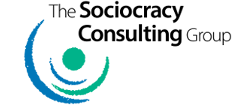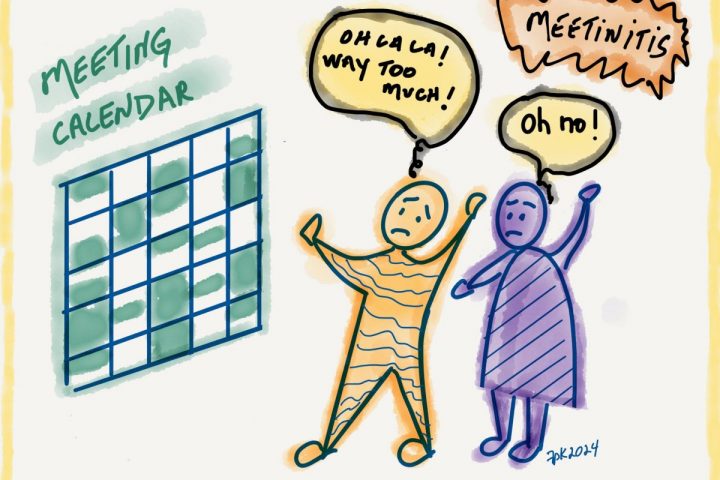 What if you could use a decision process that makes your organization smarter than any individual leader or leadership team?
What if you could use a decision process that makes your organization smarter than any individual leader or leadership team?
Leaders often ask for honest feedback to help them make better decisions. This feedback could be from people at any level of the organizational hierarchy. But what if the organizational culture discourages people from speaking up?
If the culture does encourage them, people could still be hesitant to speak up. They may have paid a price for speaking up in the past. Even if they do speak up, the leader might have a blind spot – we all have them, after all – and ignore the feedback.
What if your organization could both encourage feedback and ensure that it actually is heard?
Enter sociocracy. This method builds in circular feedback loops so that no one’s input can be ignored. It does this in two ways:
- Periodically every group of people who work together holds a meeting to set policies that guide their work. In those meetings, the members of the group interact as peers, with all voices equivalent. This equivalence is generated by
-
- carefully-crafted meeting formats to bring out the wisdom of the group
- consent-based decision-making
- training for all group members in the skills for 1 and 2 above, with additional training for members who serve as facilitators.
- Specific roles provide circular (bidirectional) feedback between groups that have more general and more specific scopes of work within the organization. For diagrams and explanation of how this works, see 5 Pitfalls of a Top-Down Hierarchy and What to Do about Them. The result is that information and feedback flow top-down and bottom-up. Information gets to where it is most relevant and useful.
And that leader’s blind spot? It becomes less limiting, since equivalence of voice and consent-based decision-making ensure that no one’s feedback can be ignored, and good ideas can come from more diverse sources.
The above assumes that people actually do speak up.
The executive director (ED) of a long term care facility introduced sociocracy when she first took on the position. She found out only later that her predecessor had been abusive to the employees. At the first few meetings, none of the employees contributed agenda items and they barely opened their mouths. Finally one of the women brought a thread-bare towel to a meeting. She showed the towel, looking down at her feet the whole time, and said, “This is disgraceful, we need new linens and towels,” and sat down. The ED, who had been waiting for just such a moment, said, “Oh my goodness, you are right. We’ll get new ones. Thank you so much.” The whole room collectively let out its breath. Because of their experience with the previous ED, they had expected the woman who spoke to be fired on the spot. From then on employees gradually began speaking up in meetings and taking more initiative outside of meetings.
Here is this phenomenon in different words and from a different sector: “When I was an enlisted man in the Navy, I wondered why the officers didn’t listen to our good ideas. When I became an officer, I wondered why I could never get the enlisted men to tell me what they were thinking. I tell you from experience that sociocracy solves this problem from both ends.” (Richard Heitfield, President, Creative Urethanes, Winchester, Virginia, using sociocracy since late 1980s)
When people from diverse sources are contributing ideas and are part of the decision process, it makes the organization smarter. But only if those new voices cannot be ignored – else the leaders’ blind spots will continue to carry the day.
If you’d like to introduce just one technique to get the best wisdom of a group, at any level from the board down, try using a round in your next meeting. Ask a question to generate ideas about a challenging topic, or to get reactions to a proposal. Each person in the meeting gives input in turn (with the option to pass), avoiding cross-talk and criticism of others’ ideas. People who are usually quiet in meetings may contribute ideas you would have missed otherwise. And people seem to think more creatively when they know everyone will have a turn without interruption. Using a round enlivens a meeting by bringing discipline to it.
Here’s another idea. You know those policies that don’t really work, yet the organization keeps following them? The next time you consider a proposal for a new or modified policy, view it as an experiment. Be clear what the goal is, then decide on the time frame and how you will know whether the policy is working. That means determining measurements and who is responsible for them. Put the experiment’s end date on the calendar, and put the policy review on the agenda for the first meeting after that date. At that meeting, look at the measurements and do rounds to evaluate the experiment based on those measurements. Then decide whether to continue the policy as is, modify it to make it work better, or throw it out and start over.
Sociocracy is a method of governance that creates more inclusive and effective organizations. It is based in part on cybernetics (the science of communications and control) and systems theory. Gerard Endenburg, a Dutch electrical engineer, designed the method half a century ago to run his electrical contracting company in the Netherlands. Businesses and nonprofits in multiple countries are using it successfully.
Thanks to John Schinnerer for editing assistance with this blog. An earlier version appeared in a guest post in the National Council of Nonprofits newsletter, Nonprofit Knowledge Matters (October, 2013).
To explore how to have more effective meetings, or to have us facilitate a meeting for you, see Your Meeting Coach or contact us for a free consultation. And see also ABC’s of (Virtual) Meetings that Rock.
 Sheella Mierson, Ph.D., a founding member of The Sociocracy Consulting Group, helps design relationships, processes, and structures for collaboration so that people and organizations flourish.
Sheella Mierson, Ph.D., a founding member of The Sociocracy Consulting Group, helps design relationships, processes, and structures for collaboration so that people and organizations flourish.




